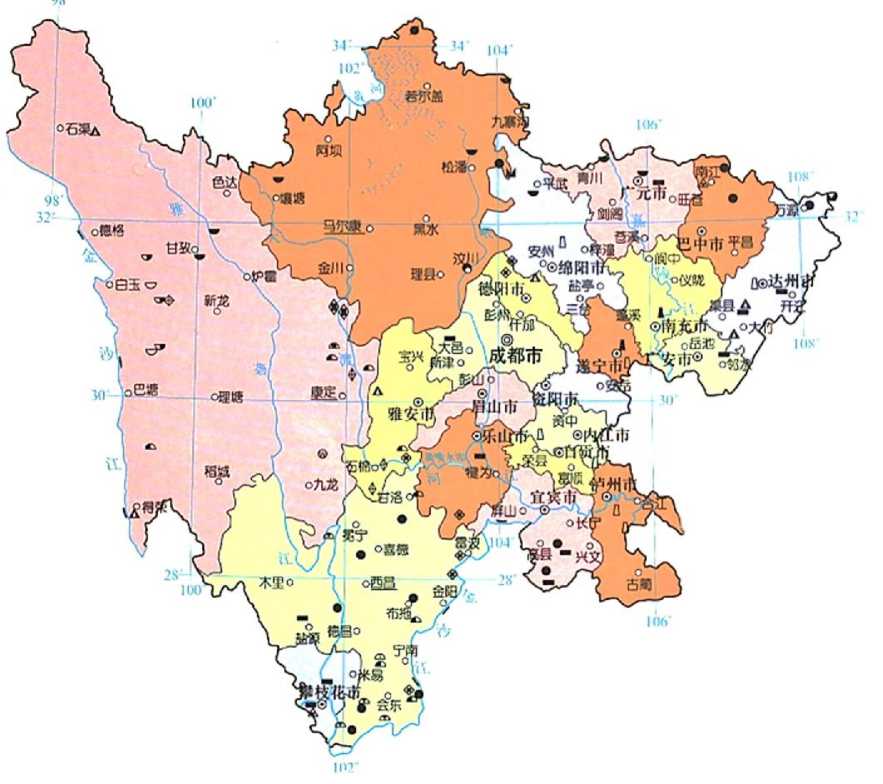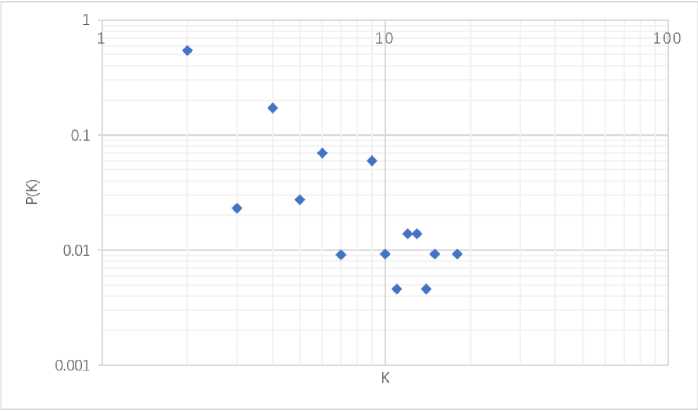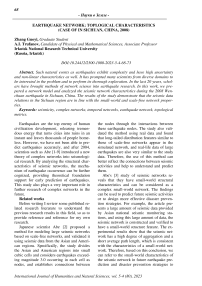Earthquake network: toplogical characteristics (case of in Sichuan, China, 2008)
Автор: Zhang Guoyi, Trufanov A.I.
Журнал: Международный журнал гуманитарных и естественных наук @intjournal
Рубрика: Науки о земле
Статья в выпуске: 5-4 (80), 2023 года.
Бесплатный доступ
Such natural events as earthquakes exhibit complexity and have high uncertainty and non-linear characteristics as well. It has prompted many scientists from diverse domains to be interested in the problem and to perform its thorough exploration. In the last 20 years, scholars have brought methods of network science into earthquake research. In this work, we prepared a network model and analyzed the seismic network characteristics during the 2008 Wenchuan earthquake in Sichuan, China. The results of the study demonstrate that the seismic data relations in the Sichuan region are in line with the small-world and scale-free network properties.
Seismicity, complex networks, temporal networks, earthquake network, topological metrics
Короткий адрес: https://sciup.org/170199810
IDR: 170199810 | DOI: 10.24412/2500-1000-2023-5-4-68-73
Текст научной статьи Earthquake network: toplogical characteristics (case of in Sichuan, China, 2008)
Earthquakes are the top enemy of human civilization development, releasing tremendous energy that turns cities into ruins in an instant and leaves thousands of people homeless. However, we have not been able to predict earthquakes accurately, and after 2004, scientists such as Abe [1-9] introduced a new theory of complex networks into seismological research. By analyzing the structural characteristics of seismic networks, the mechanism of earthquake occurrence can be further cognized, providing theoretical foundation support for early prediction of earthquakes. This study also plays a very important role in further research of complex networks in the future.
Related works
Before writing I review some published related research literature to understand the previous research results in this field, so as to provide reference and reference for my own research.
Japanese scientist Abe [2] proposed a method for modeling large seismic networks based on scale-free networks, and validated it using seismic data from the Asian and American regions. Specifically, the study divides the Asian and American regions into small cubic cells and considers earthquakes exceeding magnitude 3.0 occurring in each cell as nodes, and establishes connections between the nodes through the interactions between these earthquake nodes. The study also validated the method using real data and found that long-tailed distribution features similar to those of scale-free networks appear in the simulated network, and real-life data of large earthquakes are also very similar to the study data. Therefore, the use of this method can better reflect the connections between seismic activities and help to understand and predict them.
Abe's [3] study of seismic networks reveals that they have small-world structural characteristics and can be considered as a complex small-world network. The findings can be used to predict future seismic activities or to design more effective disaster prevention strategies. For example, the article presents a large amount of seismic data provided by Asian national seismic monitoring stations, and using this large amount of data, the seismic network is constructed and verified to have a small-world structure feature. The experimental results show that the seismic network has a high degree of aggregation and a short average path length, which is consistent with the characteristics of a small-world network. Therefore, based on this conclusion, we can refer to the small-world characteristics of the seismic network in future earthquake prediction and disaster prevention strategies to improve our understanding of and response to seismic activities.
Nastaran Lotfi [10] proposed a novel model for constructing large seismic networks based on small-world and scale-free network properties, and verified its accuracy using gephi simulations. The experimental results show that the method can better reflect the interactions between seismic activities and can predict future seismic activities more accurately. In addition, Nastaran Lotfi explores the effects of several different time scales on network construction. Shorter time scales can better reflect the interrelationships between seismic activities, but too much sensitivity may lead to too much information overload; longer time scales can reduce the missing information, but the connection between seismic activities should be missed at a large rate. In summary, Nastaran Lotfi's study provides us with a more scientific and accurate method for modeling seismic networks, which provides more reliable theoretical support for earthquake monitoring and prediction.
Model
In recent years, complex networks have attracted much academic attention as a very promising new theory. Among them, the two groundbreaking works, discovered by Watts et al [12] in 1998 and Barabási et al [13] in 1999, have caused a worldwide boom in the study of complex networks. It can be applied to areas such as biological, road and social networks and can be studied using methods such as graph theory, statistics, physics and gephi simulation. In the study of complex networks, researchers have found that real networks have small-world characteristics and scale-free features. Where small-world refers to the short distance between any two nodes in the network, scale-free refers to the fact that the degree distribution of nodes in the network follows a power-law distribution pattern, i.e., a few nodes have more connections. These findings have important implications for our understanding and application of complex networks. In the study of complex networks, the power-law exponent γ can be used to characterize the structure of the network, which usually varies between 1-2. When γ is getting smaller, it represents a more significant dominance of a few nodes, and the network is more resistant to random attacks, but vulnerable to targeted attacks; on the contrary, when γ is larger, the network is less robust, but the whole network is more stable because the nodes are more evenly connected to each other. Therefore, the study of complex networks is of great value and can provide us with a deep understanding of various types of networks in the real world and the exploration of application solutions.
Data
Sichuan is located in the southwest of China, on the Asian-European and Indian Ocean plates, and is one of the regions in China with a high frequency of earthquakes, so there are enough samples of seismic data in the region to provide reliable support for seismic data analysis. In this study, data from the 2008 Wenchuan earthquake were selected for analysis. This earthquake covered the area of 25°N-35°,90°E-110°E, and a total of 842 earthquakes occurred. The analysis of these seismic data can provide a deeper understanding of the seismic activity patterns in the Sichuan region and thus provide strong support for future earthquake prediction and disaster emergency response efforts. In this study, data provided by the National Center for Earthquake Science and Data were used for the analysis, which are highly reliable and cover a wide range of seismicity, and can reflect the earthquake situation in the Sichuan region comprehensively. Therefore, the results of this paper have a high reference value and are of great significance for the in-depth study of the characteristics and patterns of earthquakes in Sichuan and the improvement of earthquake disaster preparedness. The map of Sichuan is shown in Figure 1.

Fig. 1. Map of Sichuan, China
Seismic network construction methods
By dividing the study area into squares of equal size and treating cells with earthquakes of magnitude 3.0 or greater as nodes, two adjacent earthquakes are treated as connected points and an edge is created between them. Using this method, we can construct an earthquake network with strong stability. Take the seismic network constructed from the data of the 2008 Wenchuan earthquake as an example. As can be seen in Figure 2, each node in the seismic network represents the point in the corresponding square grid where an earthquake of magnitude 3.0 or higher occurred, while the connected edge between the nodes indicates the adjacency of the corre- sponding earthquake. This construction method can effectively avoid the correlation between data, while it can fully consider the spatial structure of seismic zones and reflect the spatial and temporal characteristics of earthquake occurrence. According to the paper of Zhou-Min Xie [9], it is known that the side length of the square lattice is between 5 km and 10 km, and the seismic network constructed using this method has strong stability [10], which can not only reflect the basic characteristics of earthquakes well, but also compare and predict the seismic activities in different regions, thus providing strong support for earthquake disaster prevention and emergency response.

^*1
Fig. 2. Wenchuan earthquake 2008 network topology
Findings
The concept of scale-free network refers to a network in which a few are heavily connected and the majority of nodes have a low number of connections. It also explores whether the Wenchuan earthquake network has scale-free characteristics, and uses the power-law distribution to describe the degree of the network distribution. Taking the seismic network of the Wenchuan earthquake for a total of one month from May 12 to June 13, 2008 as an example, the passage explores the case that its extent distribution conforms to the idempotent distribution. Through the probability degree distribution formula Р(К) ~ К — у, where k is the degree value, P(K) is the probability of occurrence of nodes with degree k, which is equal to the ratio of the number of all nodes with degree k in the network to the total number of nodes in the network, and γ is a positive exponent with an exponent between 1 and 2 for the powerlaw distribution. According to the data of the degree distribution of the Wenchuan earthquake network in Figure 3 of the paper, it can be found that the degree distribution of the network roughly conforms to the law of the Power Law distribution, i.e., a few nodes have extremely high degrees, while most nodes have relatively low degrees. This characteristic of distribution of power law indicates that the Wenchuan seismic network is a typical scale-free network, i.e., a few nodes play a dominant role in the whole network, while most nodes are in a passive position. This characteristic is not only important for the study of seismic networks, but also can provide reference for the study of other kinds of networks.

Fig. 3. The log-log plot of degree distribution
After analysis, we can find that the Wen-chuan earthquake network has scale-free characteristics, which means that the vast majority of nodes play only a small role in the network, while only a few nodes have significant influence. By analyzing the seismic data from nodes with large degree values, we find that seismic events representing the occurrence of large earthquakes are concentrated in these influential nodes. This suggests that despite the relatively small number of large earthquakes, their impact on the overall seismic network is significant. This conclusion is based on the observation from Figure 3 that the degree distribution of the seismic network satisfies a power-law distribution, showing that the seismic network appears to have the long-tail distribution characteristic of a scale-free network. Therefore, we can conclude that the seismic network conforms to the properties of a scale-free network and that a few nodes have significant influence on the whole network, which is consistent with the properties of many complex networks in the real world and reflects the laws of nature.
Conclusion
This study shows that the frequency and magnitude distribution of seismic events in the Wenchuan earthquake network conform to a power-law distribution, which implies that a few nodes have great influence on the magnitude distribution of the whole seismic network, and these nodes represent events that have often occurred as large earthquakes. This finding provides an important theoretical basis for gaining insight into the evolutionary patterns of the Wenchuan earthquake and other seismic events, as well as for predicting seismic hazards. However, it should be noted that seismic events in different regions are inherently different, and their characteristics and manifestations vary. Therefore, although the Wenchuan earthquake network conforms to the characteristics of scale-free networks, it does not mean that it is exactly the same as other earthquake networks. Future research can consider comparing and analyzing the Wenchuan seismic network with other seismic networks to explore the differences and commonalities between them and provide more accurate and comprehensive data support for research in related fields. Overall, the data in this discussion show that the frequency and magnitude distributions of seismic events in the Wenchuan seismic network con- form to a power-law distribution, which provides a theoretical basis for an in-depth understanding of the evolutionary patterns of seismic events.
Список литературы Earthquake network: toplogical characteristics (case of in Sichuan, China, 2008)
- Abe S., Past'en D., Suzuki N. Finite data-size scaling of clus tering in earthquake networks // Physica A. - 2001. - №390 (7). - P. 1343-1349.
- Abe S., Suzuki N. Scale-free network of earthquake' // Euro phys. Lett. - 2004. - №65 (4). - P. 581.
- Abe S., Suzuki N. Small-world structure of earthquake net work' // Physica A. - 2004. -№337 (1-2). - P. 357-362.
- Abe S., Suzuki N. Scale-invariant statistics of period in di rected earthquake network' // Eur. Phys. J. - 2005. №44 (1). - P. 115-117.
- Abe S., Suzuki N. Complex-network description of seismicity // Nonlin. Processes Ge-ophys. - 2006. - №13. - P. 145153.
- Abe S. and Suzuki N. Dynamical evolution of clustering in complex network of earthquakes, 2006. e-print arXiv: physics/0612058.
- Abe S. and Suzuki N. Complex earthquake networks: Hierarchical organization and assort-ative mixing // Phys. Rev. E. - 2006. - №74. - P. 026113.
- Gutenberg B, Richter C F. Frequency of earthquakes in California // Bulletin of the Seis-mological Society of America. - 1944. - №34(4). - P. 185-188.
- Ogata Y. Statistical Models for earthquake occurrences and residual analysis for point processes // Journal of the American Statistical Association. - 1988. - №83 (401). - P. 9-27.
- Lotfi N. The earthquake network: the best time scale for network construction // Journal of Geophysics. - 2015. - №60 (3). - P. 203-215.
- Watts D J, Strogatz S H. Collective dynamics ofsmall-world networks // Nature. - 1998. -№393 (6684). - P. 440-442.
- Barabâsi A.L., Albert R. Emergence of scaling in random networks // Science. -1999. -№286 (5439). - P. 509-512.
- Xie Z.M. Network topology and network dynamical behavior of seismicity // Technol Earthq Disaster Prev. - 2011. - №6 (1). - P. 1-17.


